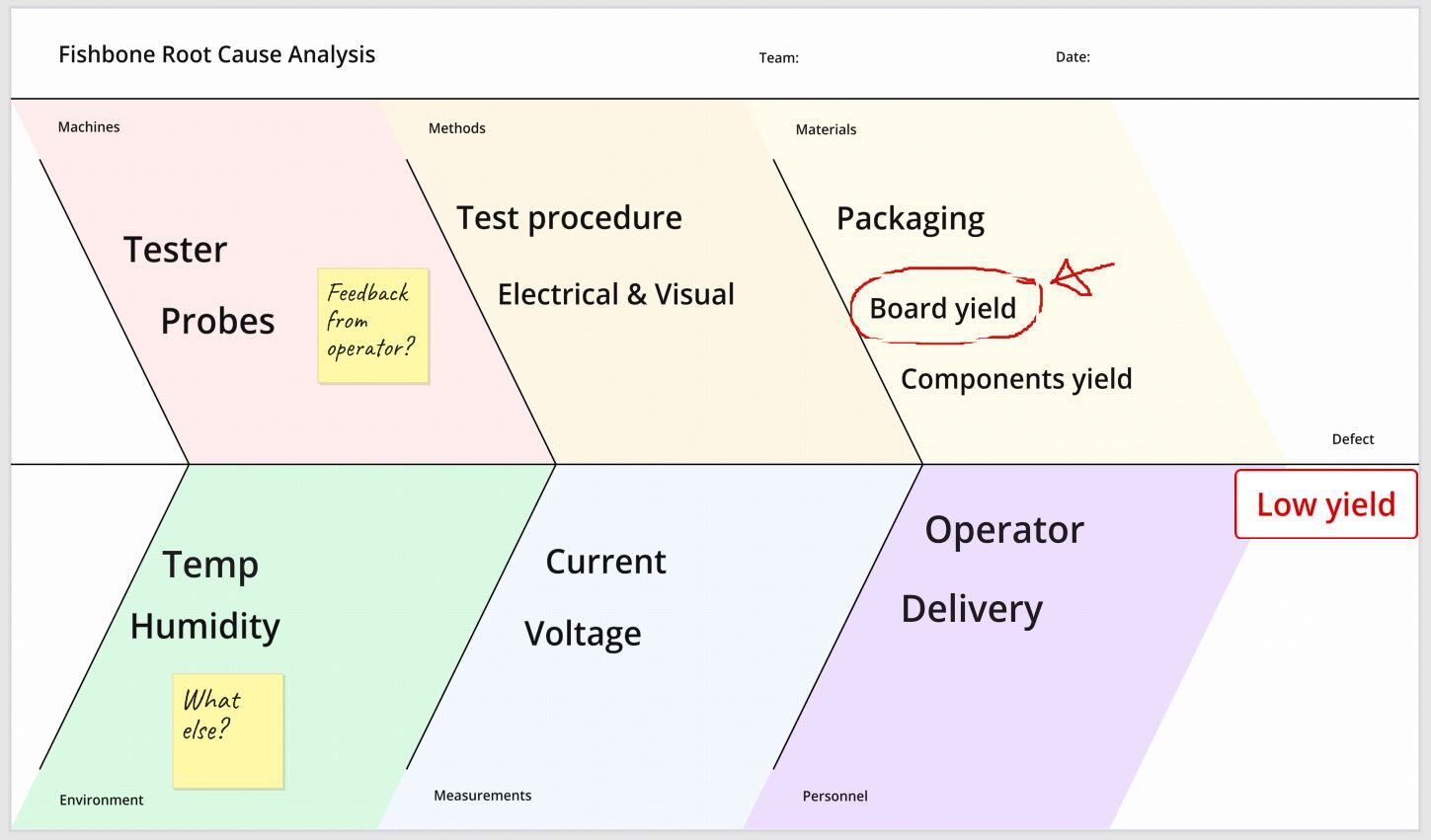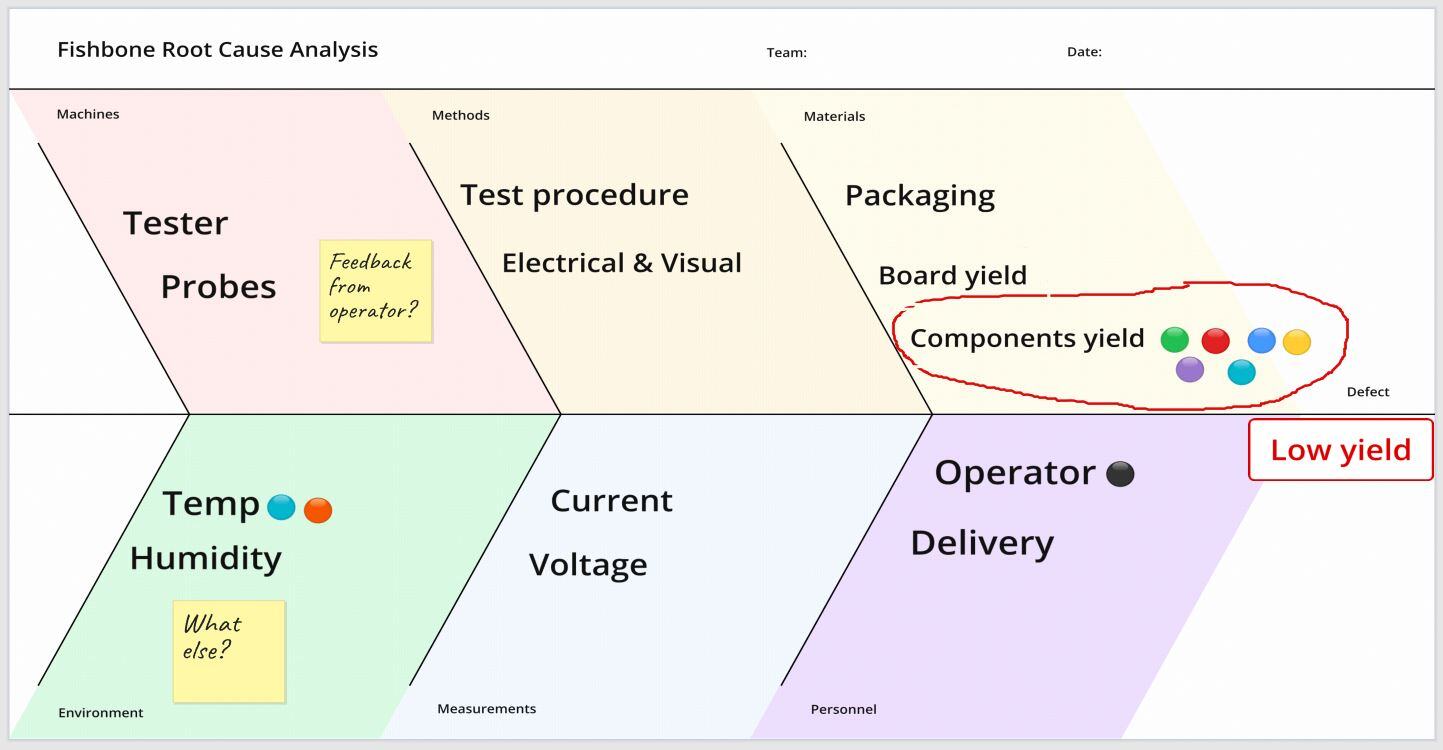Summary
The “Fishbone” Root Cause Analysis, also known as the Ishikawa method, is a basic tool for quality control. This highly visual method uses the familiar “fishbone” diagram to list potential causes of a problem, usually split into six categories: Machines/Methods/Materials/Personnel/Measurements/Environment. The free FlatFrog Board app template features these categories to help you launch a collaborative root cause analysis in practically no time, whether in the meeting room or with hybrid working. Here is how.

Running a successful Root Cause Analysis (Fishbone) workshop
First, please review our general tips for running any successful workshop,here. For a successful Root Cause Analysis workshop, the key is skillful facilitation, which begins with the planning phase. (The method itself is intuitive and straightforward.)
Before delineating the issue and identifying the root cause, the meeting facilitator must establish a collaborative analysis team. This team ideally includes six to 15 relevant members with insight into the problem. Ensure a thorough investigation by allowing at least an hour for the workshop.
The first step during the workshop session is creating a collaborative team statement of the issue, which gets placed at the “head of the fish” (labeled as ‘Defect’ in the FlatFrog template.) Everyone must come to a clear consensus on the issue/problem under discussion. It helps if the issue has been pre-communicated in broad terms to participants, allowing the first part of the meeting to produce a collaboratively agreed narrow/precise statement identifying the problem.
This requires high trust between participants, ensuring everyone has a voice and feels free to raise points of clarification. At this stage, a clear statement of the problem does not refer to any solutions. Go around the room, allowing each participant to elaborate on the issue and raise points of clarification until reaching a consensus.
The next stage is brainstorming for possible causes. As people offer answers to the question “Why does this problem happen?” the facilitator places suggestions in the appropriate six categories of the FlatFrog template: Machines/Methods/ Materials/ Environment/Measurements/ Personnel. See a more detailed explanation of these categories here.
The role of the facilitator is to ensure full participation from all members. One way to do this is to ask each team member to put a potential cause on a sticky note. Continue the rounds until suggestions are exhausted.
Often, a potentially identified cause falls under more than one category, which could be significant. For each major potential cause, ask “Why does this happen?” If necessary, identify a sub-cause using a separate “Five Whys” analysis for the primary potential causes. Place a sub-branch beneath the main causes to visually represent the entire map. This visual representation of the whole field is crucial to identifying root causes.

The “Why” analysis should continue for each potential major cause as long as new information arises. Once again, every member responds to each “Why?” by going around the meeting room until ideas are exhausted. Once this process is complete, it is time to evaluate the comprehensive set of collaboratively brainstormed potential causes. If a cause falls in more than one category, this draws attention to it as a possible root cause, and the facilitator points this out to participants.
The final step is using the visual representation to reach a consensus on the probable root cause. One method for accomplishing this is to narrow the list using a multi-voting procedure on a digital whiteboard. Ask each team member to identify three issues they think are candidates for the root cause, going around the entire room again.
Each member places a “tick” next to three potential causes listed on the board. The facilitator then tallies the ticks and identifies and circles the top three causes. Then, the second round of voting occurs, with each member placing a single dot next to one of the top three potential root causes. This process leads to a collective identity of the likely root cause.

Additional resources
- List of templates - www.flatfrog.com/templates
- Workshop use case - www.flatfrog.com/use-cases
- How can online whiteboard templates help your meeting? - www.flatfrog.com/post
- Whiteboard for hybrid work - www.flatfrog.com/post
About FlatFrog
FlatFrog is a provider of free online whiteboards (app.flatfrog.com).
FlatFrog has also designed patented InGlass™ touch display technology from the ground up, providing the best pen and touch input to mimic the intuitive feeling of a dry-erase board. InGlass™ touch displays are available through our partners, including Dell, Google, Samsung, SMART, Sharp, Ricoh, Avocor, CTOUCH and more (www.flatfrog.com/partners).


